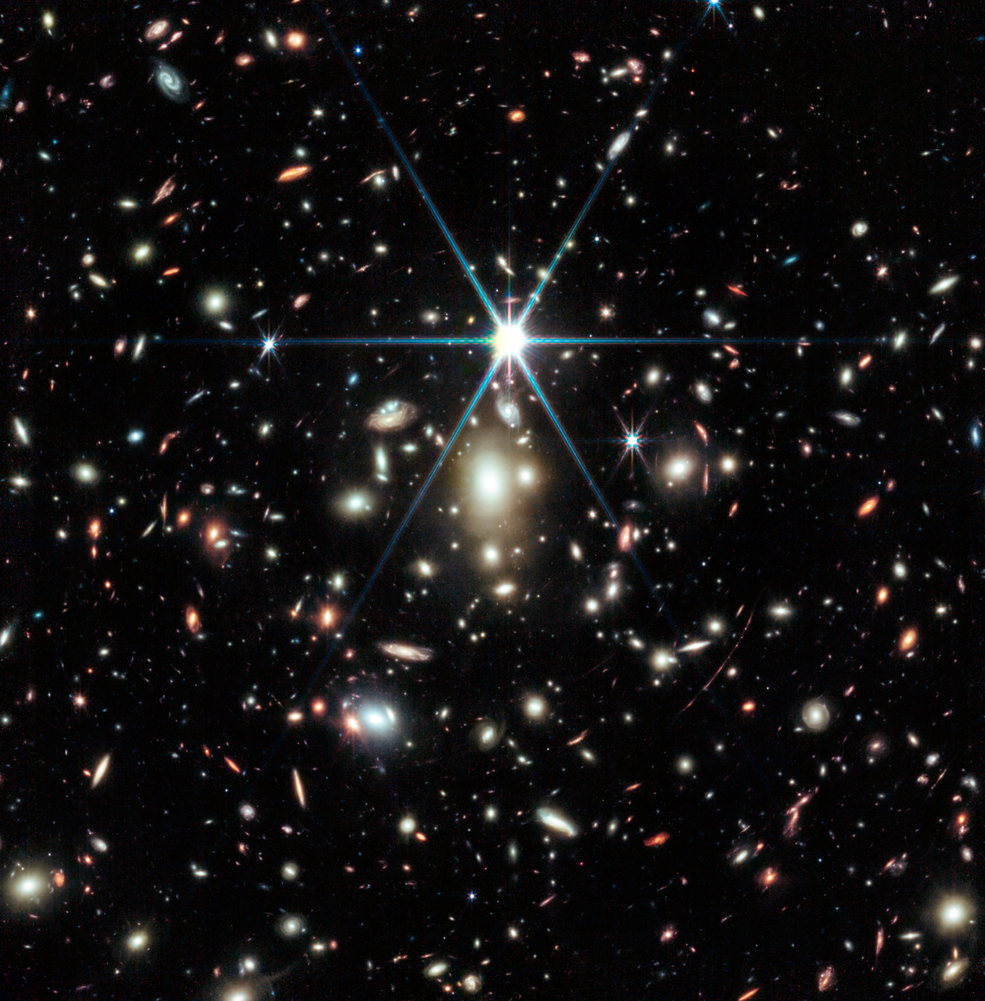NASA’s James Webb Space Telescope has tracked observations by the Hubble Space Telescope of the most distant star ever to have been detected in the highly distant universe.
 This image from NASA’s James Webb Space Telescope of a massive galaxy cluster called WHL0137-08 contains the most strongly magnified galaxy known in the universe’s first billion years: the Sunrise Arc, and within that galaxy, the most distant star ever detected. In this image, the Sunrise Arc appears as a red streak just below the diffraction spike at the 5 o’clock position. Image Credits: Image: NASA, ESA, CSA, D. Coe (STScI/AURA for ESA; Johns Hopkins University), B. Welch (NASA’s Goddard Space Flight Center; University of Maryland, College Park). Image processing: Z. Levay.
This image from NASA’s James Webb Space Telescope of a massive galaxy cluster called WHL0137-08 contains the most strongly magnified galaxy known in the universe’s first billion years: the Sunrise Arc, and within that galaxy, the most distant star ever detected. In this image, the Sunrise Arc appears as a red streak just below the diffraction spike at the 5 o’clock position. Image Credits: Image: NASA, ESA, CSA, D. Coe (STScI/AURA for ESA; Johns Hopkins University), B. Welch (NASA’s Goddard Space Flight Center; University of Maryland, College Park). Image processing: Z. Levay.
Webb’s NIRCam (Near-Infrared Camera) instrument discloses the star to be a huge B-type star compared to twice as hot as the Sun, and around a million times highly luminous.
The star, which the research group has dubbed Earendel, is situated in the Sunrise Arc galaxy and is detectable just as a result of the integrated power of human technology and nature through an effect known as gravitational lensing.
Both Hubble and Webb were capable of detecting Earendel as a result of its lucky alignment behind a wrinkle in space-time made by the huge galaxy cluster WHL0137-08.
The galaxy cluster, situated between the Earth and Earendel, is so huge that it warps the fabric of space itself, which generates a magnifying effect. This enables astronomers to look through a cluster similar to a magnifying glass.
While other features present in the galaxy show up several times as a result of the gravitational lensing, Earendel just appears as a single point of light, even in Webb’s high-resolution infrared imaging.
Depending on this, astronomers identify the object that has been magnified by a factor of a minimum of 4,000, and hence is extremely small—the farthest star ever detected, noted 1 billion years following the big bang.
The earlier record-holder for the most distant star was detected by Hubble and noted nearly 4 billion years following the big bang. One more research group utilizing Webb recently determined a gravitationally lensed star called Quyllur, a red giant star noted around 3 billion years after the big bang.
Stars as huge as Earendel usually have companions. Astronomers did not expect Webb to disclose any companions of Earendel as they would be so close together and identical in the sky.
But depending entirely on the colors of Earendel, astronomers think they get to see hints of a cooler and redder companion star. This light has been enlarged by the expansion of the universe to wavelengths longer compared to Hubble’s instruments detection, and so was just detectable with Webb.
Also, Webb’s NIRCam displays other remarkable details in the Sunrise Arc, which is known to be the most highly magnified galaxy that is yet to be detected in the universe’s first billion years. The features include older established star clusters and young star-forming regions as small as 10 light-years across.
On both sides of the wrinkle of maximum magnification, which runs right via Earendel, such features have been mirrored by the distortion of the gravitational lens. The region forming stars appears extended and is evaluated to be below 5 million years old.
The presence of smaller dots on either side of Earendel are two images of one older, more fixed star cluster, evaluated to be at least 10 million years old. Astronomers identified this star cluster is gravitationally bound and likely to continue until the present day. This displays how the globular clusters in the Milky Way might have looked when they developed nearly 13 billion years ago.
At present, astronomers are examining data from Webb’s NIRSpec (Near-Infrared Spectrograph) instrument observations of the Sunrise Arc galaxy and Earendel, which will offer accurate composition and distance measurements for the galaxy.
As Hubble’s discovery of Earendel, Webb has detected other further distant stars with the help of this method, though none quite as far as Earendel. The breakthroughs have set the stage for a new realm of the universe to stellar physics, and a new subject matter to researchers studying the early universe, where once galaxies were known to be the smallest detectable cosmic objects.
The research group has careful hope that this could be a step nearing the eventual detection of one of the very first generation of stars, made only of the raw ingredients of the universe made in the big bang—helium and hydrogen.